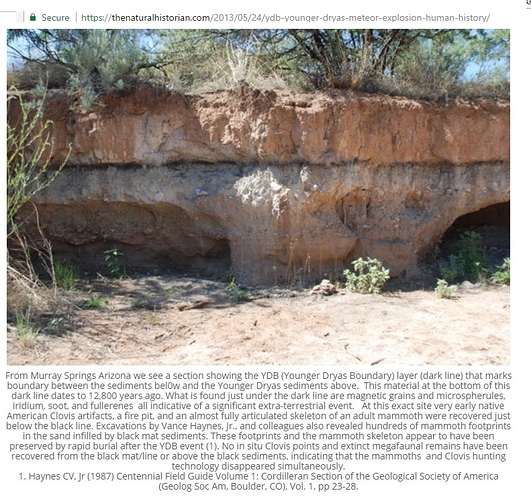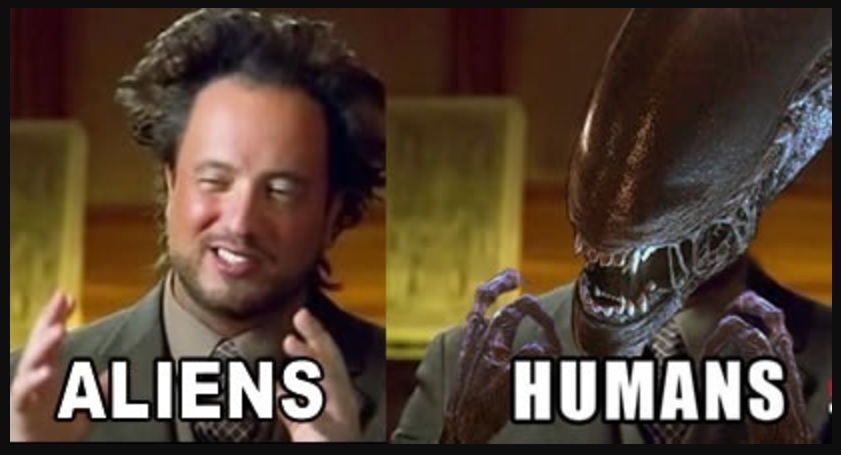Is anyone following this here? This is amazing. I am not completely sure how to interpret this in a Biblical context but this is re-writing history and changed the course of mankind. It is likely that North America ice age glaciers were hit by multiple impacts by a comet about 12800 years ago that resulted in catastrophic climate change, floods and megafauna extinction. This was the greatest extinction event for millions of years. Then about 11,600 years ago Gobekli Tepe appears during a time when man was thought to be a bunch of hunter gathers. Gobekli tepe is an advanced stone megalith that is aligned with the stars and even may have a warning about the comet. 11600 years ago was another time of significant floods and ocean rise. Then within that same period the first wheat and animals are domesticated in that same area. Something amazing happened here!
@Joel_Duff has an article about this on his Natural Historian blog:
Given that 12800 years ago is well before any biblical history (apart from creation events themselves), it doesn’t seem to me that the more recent biblical context is altered at all. That said, this is the first I had heard about this “YDB event” which (if true) is another significant part of our geologically recent history! I’ll be learning about this with interest – thanks for bringing it up.
It’s interesting to think how great of an impact writing has had on the human condition. Ancient people created all kinds of amazing monuments and cities, but if there was no record of them, we tend to know very little about the circumstances behind them. It’s almost as if they never existed. On the other hand, we seem to exist in a continuum with civilizations which produced written records.
Pretty impressive archaeology …
… but frankly, it seems to have zero to do with anything Biblical, except to demonstrate that the Earth is much older than 6000 years…
Well from a historical record there is some interesting stuff here. Whatever you want to call it is a pivotal moment in human development.
- An earth changing cataclysm like no other during the time of man.
- Significant Social behavior change brought from an unknown group to a bunch of hunter gatherers around an area that could be considered Eden. The loss of innocence eating from the fruit of knowledge. Both organized social behavior appear 6000 years before Stonehenge and megalith construction suggesting some hierarchical social order.
- Technology transfer with the advent of domesticated wheat and domesticated animals. Through painful toil you will eat fruit from the ground all your years.
Kind of makes you wonder.
I am still partial to the Great Leap Forward about 50,000 years ago. In particular the beginnings of a sense of an afterlife.
Well compare the significant behavioral changes and adaptations over the last 10000 years to any other period. It all really started here in the area of Gobekli Tepe. This is the area of Eden and this was the line of Adam that were converted from hunter gatherers to farmers with organized social hierarchy and religion. That’s a big leap forward like no other.
When you are looking at exponential curves you can get a lot of change in the most recent area of the curve, but if you look at a longer time period in the past you can get just as much change it just takes longer.
Actually the evidence indicates that agriculture originated in several places at about the same time. So while the supposed comet impact may have had an impact (pardon the pun) on human behavior it wasn’t limited to just one area.
There are indications that religion, or a belief in an afterlife at least, began well before the GLF.
Thanks for sharing, that is an amazing story. It makes sense that something along those lines happened to explain the end of the Clovis culture etc.
I am not the one that have suggested these links as the lead researcher at Gobekli tepe the late Klaus Schmidt among others. This is a paradigm shift in archeology .
This is not incongruent with the Bible Adam and Eve are naive hunter gatherers living in the garden of eden. A new advanced culture arrives after the comet and shows them a new social behavior (tempted by the fruit of knowledge) as Gobekli Tepe predates agriculture. Then with the fall from innocence agriculture (all wheat derives from here) is invented and Adam and his line must work the land to survive in the new social order. No doubt that there were other peoples all around the world, some developing agriculture but the Bible is referring to Adam and his line in the garden of Eden.
So you are saying that when the Bible says all people descended from Adam that it isn’t quite right? (playing Devil’s advocate here)
This also points out how blind the OT is to events outside of the ANE.
Overall, further studies have tended not to support the idea of an impact associated with the Younger Dryas. http://onlinelibrary.wiley.com/doi/10.1002/jqs.v32.1/issuetoc has two articles on the subject, both arguing that evidence invoked for an impact doesn’t hold up.
Thank you for the link. It is interesting science as these two groups go back and forth on the comet impact. I am sure that will take some time to get it all figured out. Remember it took years for the Alvarez’s to prove the dinosaur comet impact and I think that there are still some that dont accept it! I think the evidence is pretty good there are craters, there is an impact layer even the Carolina bays and Nebraska rainwater lakes point to an impact event literally and there are mass extinctions right at that time. Just the same Gobekli tepe also may even have a reference in the stone to this impact event. The more important point is that whatever the cause the younger dryas had a catastrophic effect on life on earth and may have caused significant changes in human behavior that led to the Neolithic revolution.
Whoah there big fella!!!
Did you just say what I thought you said? Did you just say that an advanced culture arrived on Earth from a comet?!
I sure hope they had First Class… .because I hear comets are a pretty rough ride… and steering them is almost impossible… not enough suspension …
What is of interest to me is that the people of the Bible point their origins to a time of life in the garden of Eden. Eden which is in this region of Gobekli Tepe living a life of grace living with God free of the knowledge of civilization. That they fell from Grace and converted to the social structure of civilization and then shortly afterwards wheat is domesticated and agriculture life arises right here in this area of Gobekli Tepe.
George. Haha no Aliens! The curious thing about Gobekli Tepe is that it is out of no where. There are no megalithic precursors here in this area to develop this high degree of social structure and celestial awareness. The makers of Gobekli Tepe are pretty advanced especially for 12000 years ago. The thinking by some of the Gobekli Tepe researchers is that some more advanced culture that was displaced during the Younger Dryas moved into the region of Gobekli Tepe and influenced the native people of Eden. Tempted them with the fruit of knowledge.
Just remember that this is not the only location where agriculture began. Rice was domesticated in China at about the same time for instance.
Thanks Bill. No doubt there are other humans and adaptive developments elsewhere. Yes, I am just referring to the Biblical line of Adam and their history and links to Gobekli Tepe the younger dryas/comet and the resulting adaptations that occurred here that may be recorded in the Bible.
Despite popular claims, the Carolina bays aren’t impact structures. They are ponds, shaped by prevailing winds. The pools across Nebraska (and areas north and east) are largely due to glaciers, such as kettle ponds. The impact model claims that the impactor hit the glacier and did not leave a major crater, but the evidence generally does not look good for the impact model. Note also that good-sized impacts don’t always cause significant extinction, such as the Chesapeake Bay and Popogai impacts in the late Middle Eocene.

